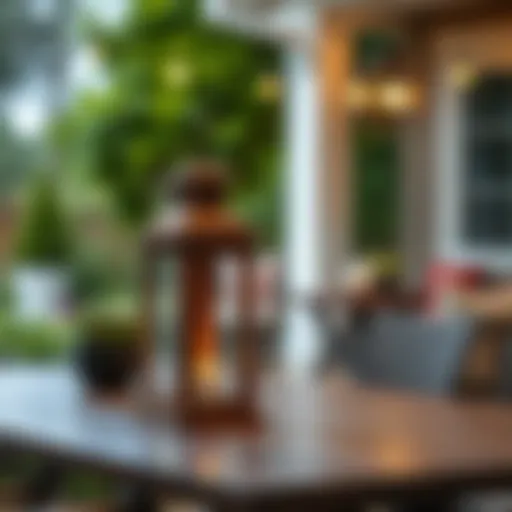Light Solid Wood Dining Tables: Style Meets Functionality
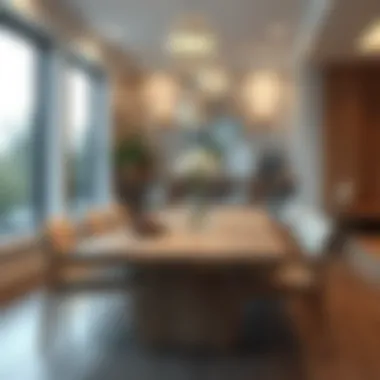
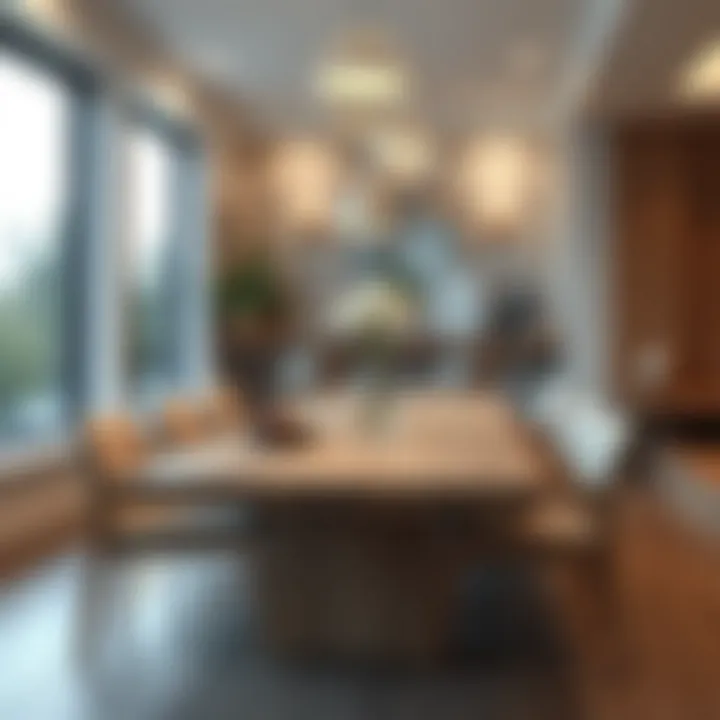
Intro
Light solid wood dining tables are not just furniture; they are the heart of your home, where memories are made, stories are shared, and meals are enjoyed. With their natural beauty and enduring strength, these tables capture a unique blend of rustic charm and modern elegance. In a world where design trends shift faster than the wind, light solid wood dining tables continue to hold their own, thanks to their versatility and aesthetic appeal.
This exploration unpacks the intricate qualities of light woods such as maple, birch, and ash. It also delves into their construction methods and design trends, helping homeowners, interior designers, and DIY enthusiasts sort through the choices available. Whether it’s about picking the right texture to match your existing decor or finding a table that fits into an open-plan lifestyle, understanding these elements is essential for making informed design decisions.
In the sections that follow, we will traverse various styles and trends, alongside essential maintenance tips, ensuring that everyone—from homeowners to seasoned designers—can appreciate the value and beauty of light solid wood dining tables. No stone will be left unturned; from modern versus traditional designs to care hacks that extend the life of your beloved pieces, we'll cover it all.
Let’s set the table and begin with a closer look at the current styles and trends influencing the world of dining tables.
Furniture Styles and Trends
Modern vs. Traditional: Understanding the Aesthetics
When you walk into a home, the dining table often serves as a focal point. And therein lies a compelling contrast between modern and traditional styles, especially when feathering light solid wood. In modern design, clean lines and minimalistic silhouettes are the reigning champions. Think of sleek tables with subtle geometric shapes that exude sophistication without being overwrought. Often paired with complementary materials, like steel or glass, these tables speak to a contemporary sensibility that values space, light, and airiness.
On the other hand, traditional dining tables charm with their ornate details and time-honored craftsmanship. They often feature rounded edges, intricate carvings, and rich stains that highlight the inherent grain of the wood. Imagine a hefty oak table with turned legs, evoking a sense of warmth and nostalgia. In many cases, traditional designs hold sentimental value, especially when passed down through generations. Each scratch and imperfection adds to its story, creating a rich tapestry of family history.
Color and Material Trends: What's In and What's Out
The palette of light solid woods holds a timeless allure. Natural finishes such as bleached oak and soft birch lend an airy quality to dining spaces, allowing sunlight to bounce off their surfaces beautifully. Pale hues harmonize seamlessly with a variety of color schemes, making them an aesthetic chameleon in any setting.
Interestingly, there’s a growing trend against high-gloss finishes that can often feel too sterile. Many homeowners are gravitating towards matte finishes that showcase the wood’s texture while offering a more organic feel. This shift signifies a yearning for authenticity, where natural imperfections are celebrated rather than concealed.
"Choosing the right color and finish can significantly impact the mood of your dining area. Light woods combined with a matte finish can evoke a serene and relaxed atmosphere, perfect for family gatherings."
Expect also to see a resurgence of mixed materials in dining tables. Tables that blend light wood with metal elements or upholstery not only embrace modern sensibilities but also provide tactile contrast. It’s a delicate dance of textures that can elicit curiosity and admiration simultaneously.
Furniture Care and Maintenance
Once you’ve settled on a table that speaks to your aesthetic, attention must turn to how to maintain its beauty. Light solid wood requires specific care to ensure it stands the test of time. Here are some practical tips:
- Regular dusting with a soft cloth prevents buildup that can scratch the surface.
- Use coasters to avoid damage from moisture or heat. A ring can mar the beauty of your wood, so prevention is key.
- Apply a specialized wood polish occasionally to nourish the grains and enhance the finish, keeping it looking fresh.
Tips for Prolonging the Life of Your Furniture
- Avoid placing your table in direct sunlight to prevent uneven fading.
- Be cautious with heavy items; avoid dropping them to minimize the risk of dents.
DIY Repair Hacks for Common Furniture Issues
- For small scratches, a simple paste made of olive oil and vinegar can work wonders. Dab it on a cotton ball and rub it gently into the scratch.
- If your table begins to creak or wobble, tightening the screws can often solve the problem without professional help.
Caring for your light solid wood dining table is all about paying attention to its needs while respecting its natural beauty. In a world filled with disposable furniture, these tables represent a commitment to quality and craftsmanship.
Prologue to Light Solid Wood Dining Tables
When it comes to choosing furniture for the home, dining tables hold a special place. They are not just surfaces for meals. They serve as the centerpiece of social gatherings and family interactions. Among the various materials available, light solid wood stands out for its unique combination of beauty, functionality, and durability. In this article, we will explore the significance of light solid wood dining tables in modern households and delve into their attributes that make them a preferred choice among homeowners and designers alike.
Light solid wood, composed of species such as Ash, Maple, Birch, and Pine, offers a fresh aesthetic that easily complements various interior design styles. These woods naturally exude warmth and elegance, often enhancing the ambiance of any dining area. The choice of light wood can brighten a space and give it an airy and open feel, making it suitable for both cozy nooks and grand dining rooms.
One of the primary benefits of light solid wood is its durability. Unlike composite materials, solid wood maintains its integrity over time, resisting wear and tear associated with daily use. This longevity means that the investment in such a dining table pays off not simply in years but through moments shared around it. It’s natural to develop sentimental attachments to these pieces, as they often witness family milestones and celebrations.
In addition to contributing to the functionality of a home, light solid wood tables play a critical role in promoting sustainable living. Many consumers are becoming increasingly conscious of their environmental impact. The use of locally sourced woods and eco-friendly practices in the production of these tables speaks volumes to environmentally aware homeowners.
There are also considerations regarding the maintenance and care of solid wood dining tables. While they are incredibly durable, they require reasonable care to preserve their finish and structural integrity. Understanding how to clean, protect, and maintain these surfaces can extend their lifespan significantly. This aspect appeals particularly to DIY enthusiasts, who find joy in taking an active role in maintaining their home’s furniture, adding a personal touch to their living space.
"A dining table is more than just furniture; it’s where memories are made, conversations are had, and bonds are formed."
The Characteristics of Solid Wood
Understanding the characteristics of solid wood is crucial for anyone looking to invest in durable and aesthetically pleasing furniture, especially dining tables. In the world of home decor, solid wood stands out due to its unmatched resilience and inherent beauty. As a natural material, it offers a unique charm that simply can't be replicated by synthetic alternatives.
Understanding Solid Wood
Solid wood refers to lumber that comes from trees and is cut into planks. Unlike engineered wood, which may incorporate adhesives and synthetic materials, solid wood maintains the original properties and atmosphere of the tree it is harvested from. This authenticity gives solid wooden tables their distinctive appeal.
Key Characteristics of Solid Wood:
- Natural Variation: Every piece of solid wood tells a story. The grain patterns can vary significantly from one plank to another, making each table a one-of-a-kind masterpiece. This uniqueness can be particularly attractive to homeowners who value individuality in their decor.
- Longevity: Solid wood is known for its durability. Unlike its softer counterparts, hard woods like oak and maple can withstand the rigors of daily use. Dining tables made from these materials can last generations, making them not just furniture, but family heirlooms.
- Flexibility in Design: Solid wood can be crafted into various styles, from sleek and modern to rustic and traditional. Homeowners have a wide range of options when it comes to choosing a table that fits their decor style, thanks to the versatility of solid wood construction.
- Sustainability: When sourced responsibly, solid wood can be an eco-friendly choice. Many trees are harvested in sustainable ways, ensuring that forestry practices do not damage ecosystems. This approach makes solid wood dining tables appealing to those conscious of their environmental impact.
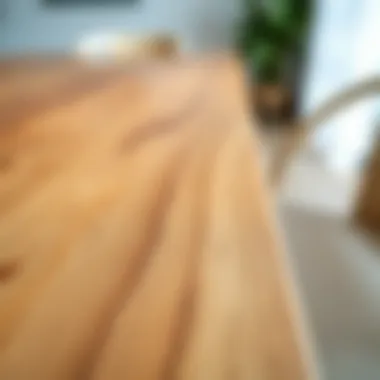
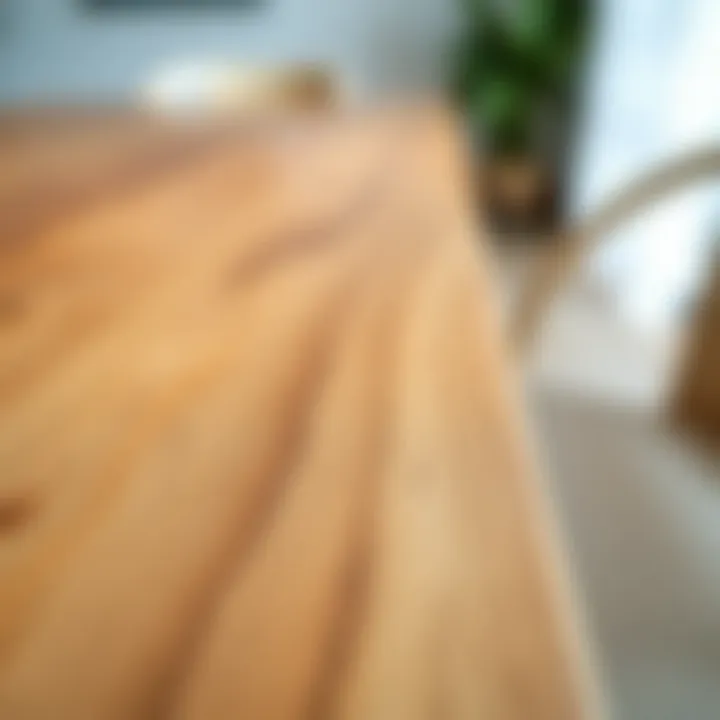
"Investing in a solid wood table is not just about choosing furniture; it's about making a statement that blends style, sustainability, and heritage."
Benefits of Solid Wood Construction
When considering a dining table, the benefits of opting for solid wood construction become apparent. This choice impacts both functionality and aesthetic appeal in several key ways.
- Strength and Stability: Solid wood can handle more weight compared to particle board or MDF. This makes solid wood tables ideal for accommodating heavy items, be it a feast for a holiday gathering or standard everyday dining.
- Refinishing Potential: Over time, even the most durable surfaces may show signs of wear. Solid wood can be sanded and refinished, allowing owners to maintain their furniture’s original charm. This feature adds to the longevity and appeal, allowing tables to morph alongside changing decor trends.
- Inherent Insulation Properties: Solid wood possesses natural insulation qualities that can help regulate temperature and reduce noise. This unique characteristic creates a more pleasant dining experience, minimizing distractions during meals.
- Aesthetic Appeal: Generally speaking, solid wood has a warming quality that can enhance any room's ambiance. It effortlessly integrates into various designs, offering classic beauty and adaptability. Whether in a minimalist setting or a grand traditional dining room, solid wood shines.
In short, the characteristics of solid wood not only define its physical presence but also contribute significantly to how it enhances a living space. Selecting a dining table crafted from this material can infuse your home with a touch of nature’s elegance while ensuring a sturdy and timeless centerpiece for gatherings.
Exploring Light Woods: Species and Attributes
Understanding the diversity of light woods is crucial when choosing a solid wood dining table. Different species come with distinct properties, influencing aesthetics and function. Each type carries its vibe and impact on interior design, while their unique characteristics also dictate how they should be cared for and maintained. An informed choice about wood selection can elevate your dining space, marrying style with practicality. Let's dive deeper into the popular light wood varieties.
Popular Light Wood Varieties
-### Ash
Ash is often admired for its robust nature and striking grain patterns. This species is frequently used in furniture making thanks to its flexibility and resilience. In the context of light solid wood dining tables, Ash provides a warm yet contemporary feel. Its light color can brighten a room and complement various decor styles. The unique characteristic of Ash is its open grain, giving it a natural aesthetic that showcases the wood's inherent beauty. However, it can be susceptible to scratches, which means careful handling is essential.
-### Maple
When considering a table, Maple stands out for its smooth texture and fine grain. This wood is often chosen for both modern and traditional designs due to its neutral tones that can easily blend with other furnishings. A defining trait of Maple is its durability, making it ideal for families who expect wear and tear. It handles stains well, allowing for a variety of finishes that can suit personal tastes. Nonetheless, its light color may show dirt or scratches more readily than darker woods, requiring thorough maintenance.
-### Birch
Birch has gained popularity for its light yellowish hue and subtle warmth. It is a strong yet lightweight option, making it an excellent choice for versatile dining tables that can be moved as needed. Birch's appealing visuals—including a fine grain—make it attractive for furniture. Additionally, its natural resistance to shock impacts durability, which remains a significant consideration for furniture longevity. However, Birch is not impervious to scratches and dents, thus regular upkeep is advised to sustain its pristine look.
-### Pine
Known for its unique knots and rustic charm, Pine is another go-to choice for dining tables. The key characteristic of Pine is its lightness, which means furniture crafted from this species can be easily maneuvered in a room. One major advantage of Pine is its cost-effectiveness, making it accessible for a broader audience. However, its softer nature means it can be prone to dents and scratches; thus, maintaining a protective finish is a smart strategy.
Identifying Wood Density and Grain Patterns
When assessing the quality and suitability of a dining table, wood density and grain patterns are fundamental aspects.
Understanding Wood Density
A denser wood generally indicates better durability and strength. A soft wood might not withstand the rigors of everyday use, making the density of the chosen wood vital for a dining table's longevity.
Recognizing Grain Patterns
Grain patterns not only affect aesthetics but can also hint at the overall quality of the wood. For instance, an attractive grain may enhance a table's beauty, while a more uniform appearance can lend a modern or minimalist vibe.
In summary, understanding the specific attributes of light wood species profoundly impacts not only the aesthetics but also the functional durability of solid wood dining tables.
Design Trends in Light Solid Wood Dining Tables
The design landscape of light solid wood dining tables has undergone a fascinating transformation, reflecting not just aesthetic preferences but a broader conversation about sustainability and functionality in our living spaces. These tables serve not only as a central gathering point for meals but as foundational pieces that set the tone for the entire room. As homeowners and designers alike embrace these versatile options, it’s important to understand the current trends that shape this market. The trends stem from a desire for individuality and a connection to nature, making light solid wood a sought-after choice.
Contemporary vs. Traditional Designs
In recent years, contemporary designs have gained traction, breaking away from the ornate embellishments typical of traditional styles. Today’s light solid wood tables often feature clean lines, minimalistic silhouettes, and a blend of materials. For instance, a table with a light maple surface and sleek metal legs illustrates the harmony that comes from fusing different textures—adding depth to a modern aesthetic.
On the flip side, traditional designs maintain their charm with robust character and intricate detailing. Think of a rustic birch table with turned legs and a distressed finish, evoking nostalgia and warmth that many families cherish. These designs are perfect for those who want to summon a lasting sense of comfort and history into their dining area.
Homeowners should consider where they want to sit on the design spectrum. For a more vibrant, social atmosphere, a contemporary table might invite playful conversations, while a traditional piece often stirs a sense of timeless family gatherings. Ultimately, the choice reflects personal style and can significantly influence the dining experience.
Sustainable and Eco-Friendly Practices
As awareness about environmental impacts grows, more consumers are opting for furniture that blends aesthetics with sustainability. Light solid wood dining tables are at the forefront of this movement. Many of these tables come from responsibly harvested wood, emphasizing the importance of preserving our forests for future generations. Brands are increasingly focusing on sourcing wood from certified sustainable forests, which can often be tracked back to their origin, ensuring both the quality and responsibility of the product.
Moreover, sustainable practices extend beyond the material selection. Many manufacturers are adopting low-impact production techniques, which not only help reduce waste but also empower local artisans. By investing in these pieces, consumers not only adorn their homes with stunning furniture but also contribute to a more sustainable economy.
To adopt eco-friendly practices at home, consider:
- Recycling and reusing existing materials for furniture projects.
- Investing in furniture made from reclaimed wood, which often boasts unique character and history.
- Caring properly for your tables to extend their longevity, which can significantly mitigate the need for future replacements.
The Role of Light Solid Wood Tables in Interior Design
The role of light solid wood tables in interior design is paramount. These tables serve not just as functional pieces of furniture but as integral elements that shape the overall atmosphere of a space. Their significance lies in the balance they strike between practicality and aesthetic appeal. Homeowners and designers often choose light solid wood for its versatility, allowing it to seamlessly fit into various decor styles while always imparting a sense of warmth and elegance.
A light solid wood dining table can be the centerpiece of a room, drawing the eye and inspiring the design of surrounding elements. When considering color palettes, textures, or even lighting, a well-chosen wood table can tie a room together, establishing an inviting space where family and friends gather.
Balancing Aesthetics and Functionality
In interior design, achieving a balance between aesthetics and functionality is crucial. Light solid wood tables excel in this regard. Not only do they offer a stylish appearance, but they also possess durability, catering to the practical needs of everyday dining.
Aesthetically, these tables lend themselves to countless styles, from sleek modern designs to classic rustic ones. Functionally, solid wood tables stand the test of time, resisting warping and scratches better than many alternatives, thus making them a smart investment.
Moreover, with the right finish and care, these tables can retain their beauty while serving their purpose effectively. Importantly, every time the table is used—whether for a family dinner or a casual coffee session—its presence enhances the experience.
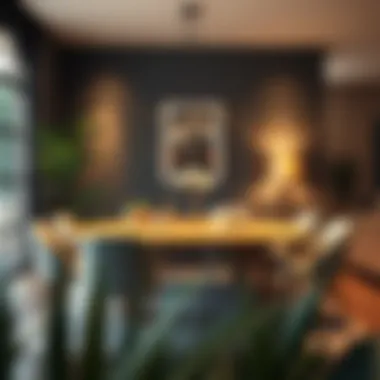
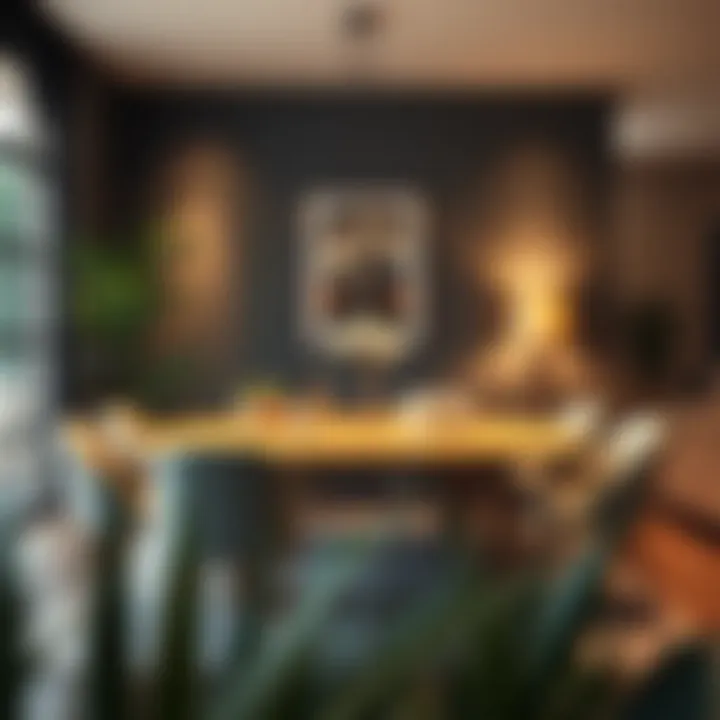
Integrating Tables into Various Decor Styles
Integrating light solid wood tables within different decor styles demonstrates their versatility. Here are a few popular styles:
Minimalist
The minimalist style values simplicity and functionality, which light solid wood tables embody perfectly. The key characteristic here is clean lines and a lack of excess decoration. A light wood table fits gracefully into this ethos, offering a straightforward yet elegant look that prioritizes presence over pretension.
What makes the minimalist aesthetic a popular choice is its ability to create calm and uncluttered spaces. Light solid wood’s natural grain can add just the right amount of warmth, making an otherwise cold, stark room feel more inviting.
Rustic
Rustic design focuses on natural materials and finishes, which makes light solid wood tables a natural fit. The key characteristic of rustic decor is its organic warmth and charm. A light wood table, perhaps featuring a live edge or a distressed finish, allows this style to shine by grounding the space in something earthy and texturally rich.
The unique feature of rustic design is that it promotes a sense of history and authenticity. However, the challenge lies in ensuring that the rustic table does not overwhelm the rest of the decor, which can happen with overly bulky designs.
Scandinavian
Scandinavian style champions functionality paired with beauty, and light solid wood tables embody this ideal. The hallmark of this design is minimalism infused with coziness. Light woods create a bright and airy feel, contributing to the overall serenity that is essential in Scandinavian interiors.
The unique advantage of Scandinavian style is its blend of form and function, promoting comfort alongside practicality. However, one must be cautious to not stray too far into over-decorating, as the core of this approach is about maintaining an unobtrusive elegance.
In summary, light solid wood tables play a foundational role in the evolving narrative of interior design. They adapt to personal tastes and styles while upholding a timeless quality, making them a favored choice across a spectrum of aesthetics.
Maintenance and Care for Light Solid Wood Tables
Ensuring the longevity and visual appeal of light solid wood dining tables hinges on proper maintenance and care. These tables, constructed from natural wood, demand attention and consideration to keep them in tip-top shape. Investing time in maintenance doesn’t just preserve their beauty; it enhances the overall atmosphere of your dining area, making it a welcoming and warm space for gatherings.
A well-cared-for table tells a story of elegance, harmony, and resilience. Light wood, such as birch or maple, can age beautifully if properly maintained. With the right approach, you can minimize wear and keep your table shining like new. The care you provide can reduce the likelihood of repairs and extend the life of your investment.
Cleaning Techniques and Recommended Products
When it comes to cleaning your light solid wood table, less is often more. Avoid harsh chemicals, as they can strip away the wood’s finish and dull its shine. Instead, consider using a damp microfiber cloth for routine dusting. Here are a couple of products that could be sound choices:
- Mild Dish Soap: A few drops mixed with warm water can effectively lift dirt.
- Wood Conditioner: This helps in rejuvenating and nourishing the surface, providing a protective layer against daily wear.
Apply a little wood conditioner periodically; it acts like a spa treatment for your table, keeping the wood hydrated and resistant to spills.
Preventing Damage and Wear
Maintaining your light solid wood table also involves anticipating and preventing potential damage. Here are some common concerns:
Scratches
Scratches are a real pain point for any wooden table. They can detract from the overall appeal and signal neglect. Instruments used for heavy meals or lack of coasters can leave marks. However, scratches can often be minimized with simple preventive measures. Coasters and placemats are your best friends here. Not only do they protect the surface, but they also lend a touch of style.
To deal with scratches that do occur, consider using a wax stick that matches the table’s finish. It’s a quick fix for minor imperfections and can make a noticeable difference in appearance.
Water Damage
Water damage is another insidious enemy. Light woods can absorb moisture, leading to warping or staining. A wet cloth left unattended can turn into a nightmare. Always use coasters for drinks, and don’t set damp items directly on the table. If any spills happen, clean them immediately with a soft cloth. Using a food-safe wood oil can also provide a barrier against moisture, ensuring your table stays fresh and dry.
Sunlight Exposure
Direct sunlight can fade the color and sheen of light solid wood tables. Over time, UV rays can cause discoloration and even weaken the wood structure. This can be quite sneaky since one might not notice until significant damage is already done. Consider placing your table away from large windows or using sheer curtains to filter sunlight. Alternatively, a decorative tablecloth can offer protection when the sun beats down, especially during the summer months.
By implementing these strategies, the versatility and aesthetics of your light solid wood dining table can be preserved and enhanced. Armed with the right knowledge and tools, you can ensure that your dining table remains a focal point in your home for years to come.
Customization and DIY Options
Light solid wood dining tables not only enhance the aesthetic appeal of a home but also offer a unique opportunity for personalization. The ability to customize and engage in DIY projects with these tables can elevate them from mere furniture pieces to cherished family heirlooms or statement pieces.
Personalizing Your Dining Table
Every homeowner aspires to create a space that resonates with their sense of style and personality. Personalizing a light solid wood dining table plays a crucial role in achieving that uniqueness. Here, customization could range from selecting the type of wood, finishing methods, or unique design elements that align with one’s home decor.
- Choice of Wood: Opting for a specific light wood variety such as maple, birch, or ash can significantly influence the overall appearance. Each type has its own grain pattern, color tones, and texture, which can affect how the table fits into the desired aesthetic.
- Design Elements: Features like engraved patterns, inlays, or even custom legs can redefine a table’s look. For example, a rustic farmhouse table with distressed wood finish might contrast beautifully in a modern, sleek environment, bringing an unexpected twist.
- Finishing Touches: The finish, be it matte, glossy, or a more organic oil finish, impacts not only the look but also the feel of the table. Custom finishes can enhance the grain and add hours of enjoyment as family gathers around the table for meals.
By taking these elements into account, a dining table can become more than just a piece of furniture; it can embody the lifestyle of its owners.


DIY Projects for the Enthusiast
For those who find joy in creating, there are numerous DIY projects that can accentuate the uniqueness of a light solid wood dining table. These activities not only foster creativity but also allow for a hands-on approach to crafting a piece that speaks to one's personal taste.
Here are some engaging ideas:
- Refinishing and Restoring: If you have an old table, consider refinishing it. Stripping away the old finish and applying a fresh stain can revive its beauty, giving it a new lease on life.
- Creating Custom Table Legs: Many enthusiasts have found joy in designing their own table legs. Whether it's a hairpin metal style or chunky wooden legs, adding these unique touches can truly transform the table
- Tabletop Art: Another creative option is to create a resin art table by embedding materials like flowers, leaves, or even photos into the resin. This keepsake serves as a conversation starter at any dinner party.
- Conversion Projects: Some creative individuals transform smaller tables into larger dining setups. This could involve joining two smaller tables or adding extensions that blend seamlessly with the existing wood.
These DIY options not only serve as a way to express creativity but also contribute to the sustainable practice of reusing and repurposing materials.
By embracing the aesthetics of these tables, homeowners gain not only functional furniture but also a piece of art that embodies their lifestyle and preferences.
Cost Considerations for Light Solid Wood Dining Tables
When thinking about light solid wood dining tables, cost is a factor that can’t be brushed under the rug. It’s a bit like trying to choose a pair of shoes — you have to weigh quality against your budget. In terms of light wood dining tables, several specific elements come into play that can greatly influence the overall price. Quality, size, finish, and craftsmanship all contribute to the cost.
One of the main advantages of investing in solid wood is its durability, something that many homeowners appreciate. You want to know if you’re spending wisely, especially since these tables can be sizable investments. While a cheap table might seem like a steal at first glance, it could lead to more expenses down the road.
Understanding Price Variability
The price of light solid wood dining tables isn’t set in stone. You’ll find a range of prices due to various factors. For instance, consider the type of wood being used. Ash and maple may carry a different price tag compared to pine and birch. Here are some key elements that affect costs:
- Wood species: Some light woods are rarer than others, which inherently raises their cost.
- Table size: Large tables often demand higher prices due to increased material and labor costs.
- Craftsmanship level: Handmade tables will typically command higher prices than mass-produced items.
- Finishes and treatments: High-quality finishes or unique treatments add to the price.
When exploring your options, understanding this variability can enable better budgeting and planning. Buying a table that fits your aesthetic and functional needs is often worth the extra dollar.
Investing in Quality: What to Expect
Now, about that investment. When you decide to put your money into a high-quality light solid wood dining table, what can you truly expect? First and foremost, longevity is often the name of the game. Solid wood, when properly cared for, can last generations. Unlike particleboard or cheap veneers that can warp or peel, solid wood tables can withstand the test of time with graceful aging.
You should also expect a certain level of craftsmanship. A well-crafted table will not only have a pleasing aesthetic but will also be functionally superior. Here’s a rundown of what quality means in this context:
- Sturdy Construction: Quality woods are typically more robust and stable, reducing the risk of warping.
- Beautiful Grain Patterns: Good tables showcase the beauty of the wood, making them focal points in any room.
- Custom Finishes: Expect unique finishes that enhance both beauty and durability.
- Resale Value: Well-made solid wood tables can retain or even increase in value over time.
In the long run, taking the plunge on a solid wood dining table is often a rewarding endeavor, combining the elements of style, durability, and long-term value. As the saying goes, sometimes you have to spend a little more to get a lot more.
The Popularity of Light Solid Wood in Modern Homes
In a world where interior design trends seem to shift quicker than you can say "minimalism," light solid wood dining tables have carved out a long-lasting niche in modern homes. The warmth and character of natural wood have continuous appeal not only because they serve as practical furniture solutions but also due to their aesthetic versatility. Homeowners today are shifting towards sustainability, durability, and timeless elegance, making light solid wood an increasingly popular choice.
Why Homeowners Prefer Light Wood
When it comes to selecting materials, many homeowners lean toward light solid wood for various reasons. Here are several compelling factors:
- Natural Beauty: Light woods like birch, maple, and ash display beautiful grains and tones that can easily complement any color palette or interior style.
- Illuminating Effect: The lighter hues can brighten and open up spaces, making them feel larger and more inviting. This becomes especially important in compact apartments and smaller homes.
- Sustainability: More buyers are now eco-conscious and prefer materials sourced from responsibly managed forests. Light solid wood often comes from sustainable practices that appeal to the environmentally minded consumer.
- Durability: Solid wood is considerably more resilient than laminate or other artificial materials. Proper care can keep a light wood table looking gorgeous for decades.
- Versatility in Design: The simplicity of light wood makes it adaptable. It can fit into a modern sleek design or a more rustic and inviting atmosphere. It’s akin to that trusty pair of jeans that go well with anything—perfect for mixing and matching.
As a result, light solid wood dining tables are not merely pieces of furniture. They are central elements in creating a harmonious living space that merges function with flair.
Case Studies: Successful Implementations
To further illustrate the growing popularity of light solid wood tables, let’s look at a couple of interesting case studies that showcase their successful integration in diverse environments:
- Urban Loft: In a chic urban apartment with exposed brick and industrial accents, a large light maple dining table serves as the centerpiece in the dining area. The table’s light color contrasts greatly with the darker surroundings, drawing the eye and inviting dining experiences. Its clean lines echo the contemporary style while offering warmth to balance the hardness of the surrounding materials.
- Family Home in Suburbia: A rustic birch table in a family-oriented dining area creates a cozy atmosphere. Its large extension features allow for crowd-pleasing gatherings, reinforcing the table's role as a favorite gathering spot. The natural finish enhances its character while age-related wear and tear add more charm, testifying to the adventures of family life.
- Scandinavian Design: In a sleek Scandinavian home, a simple yet elegant ash dining table takes center stage, blending perfectly with soft color schemes and minimalist décor. Its understated beauty aligns with the philosophy of incorporating functional objects into living spaces, making it a prime example of a well-designed home.
In each of these scenarios, light solid wood dining tables not only fulfill functional purposes but also enhance the aesthetics of their surroundings. Their ability to adapt to various styles makes them a staple in homes across the modern landscape, proving they truly are versatile companions.
The End: The Enduring Appeal of Light Solid Wood Dining Tables
Light solid wood dining tables hold a special place in the hearts and homes of many. Their versatility allows homeowners to effortlessly blend them into various design schemes, from minimalistic spaces to warm, rustic areas. This adaptability isn’t merely about appearance; it speaks volumes about how such tables harmonize with our lifestyles and how we gather.
One compelling aspect of light solid wood dining tables is their timeless nature. Unlike other materials that may fall out of favor, the aesthetic integrity of wood endures. The gentle grain patterns and natural hues of light woods such as birch and ash provide warmth to a dining area. These tables seem to gather stories as families come together for meals, celebrations, or casual chats over coffee.
Moreover, the durability of solid wood means these tables are not just a short-term investment. They withstand the tests of time and, with proper care, can be passed down through generations. The notion of durability extends beyond functionality; it brings a sense of security in one’s home, knowing that their furniture can withstand everyday use while retaining its appeal.
When discussing maintenance, it's worth noting that caring for light wood surfaces is less daunting than it may seem. Simple measures like using coasters, regular cleanings, and occasional refinishing can ensure that a solid wood table keeps its luster and charm.
Here are some benefits worth mentioning:
- Aesthetic Flexibility: Compliments a range of decor styles.
- Natural Material: Environmentally friendly compared to synthetic alternatives.
- Unique Characteristics: Each piece tells a story through its grain and coloring.
- Longevity: A long-term investment that adds value to a home.
As sustainability grows in importance to consumers, light solid wood dining tables align well with eco-friendly practices. Many manufacturers focus on responsible sourcing, using woods that are harvested ethically and helping support forest regeneration. This commitment to sustainability resonates with today’s discerning buyers, who value transparency in sourcing materials.
"A table is a shared space. It brings people together, creating connections that outlast time itself."
For those curious about maintaining their wooden furniture, resources from Wikipedia and Britannica can offer valuable insights on care and history. Meanwhile, joining discussions on platforms like Reddit can provide tips from fellow enthusiasts.
Thus, as we consider the incorporation of light solid wood dining tables into our homes, let's appreciate their elegance and the understated intricacies they bring to our lives.



